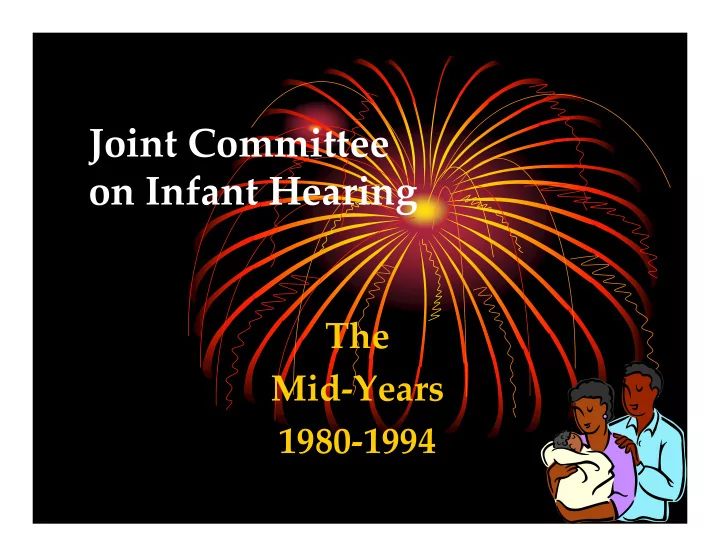

Joint Committee on Infant Hearing The Mid ‐ Years 1980 ‐ 1994
Early JCIH Emphasis • The Challenge: • Identify, evaluate and apply valid and reliable measures of hearing in infants and toddlers. • We do NOT identify 50% of children w ith hearing loss using high risk registries (Stein and cow orkers).
Evolution of Technologies and Pilot Studies • Audiologists restive about applying new technologies to EI; frustration re late identification and subsequent consequences. • DOE and Tom Behrens, sow ed seeds w ith HRSA re: development of state projects to assess new born screening.
Policy Conflicts and JCIH Membership • AAP--universal hearing screening w as conceptually sound, but … scientific evidence of value w as lacking. • Expense and qualified personnel issues. • AAP cited barriers to implementation in new born nurseries.
Policy Conflicts and JCIH Membership • Council on Education of the Deaf • JCIH had an aural-oral emphasis and motivation tow ard early hearing detection. • Opposition to the practice and policy related to the advent of cochlear implants.
JCIH 1982 • Expanded the risk criteria to 7. • Screening by 3 months and no later than 6 months. • no endorsement for any specific electrophysiologic procedure • Added need for medical treatment and education intervention. • Screening ‘under the supervision of an audiologist’
Reforming Alliances: JCIH 1990 • AAP representation. • CED representation. • Expansion of risk criteria delineating different age groups (birth-28 days; 29 days to 2 years). • Added ototoxic medications, prolonged mechanical ventilation and head trauma to risk criteria. • Screening at risk babies at birth prior to discharge or before 3 months. • Recommended ABR screening, not behavioral screen due to high false positives.
JCIH 1990 • Detailed outline of optimal early intervention services (PL 99-457). • Caveats about updating risk criteria; need for risk review every 3 years.
JCIH 1994 • Supported the goal of universal detection of hearing loss as early as possible • All infants should be identified by 3 months of age, intervention begun by 6 months of age.
A BIG THANK YOU!!! • MARIAN DOWNS • EVY CHEROW
Lessons in Diplomacy and Science • High risk registry = A reasonable moderate public health approach to early identification & professional education to administer high risk registries
JCIH 1982 • DEFINED • Screening by 3 months and no later than 6 months: no endorsement for any specific objective electrophysiologic procedure • Diagnostic procedures: behavioral and objective • Management: Audiologic, medical and psychoeducational
Recommend
More recommend